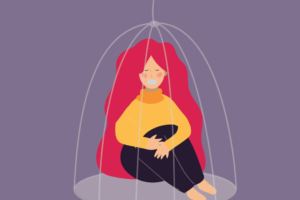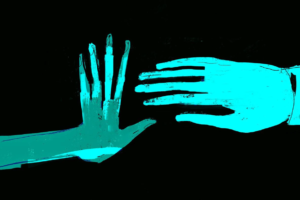By Amanda Kippert
Domestic violence and abuse are insidious crimes, meaning that abusers often sneak up on their victims. As many survivors will tell you, an abuser didn’t come into their life waving a big red flag, declaring their intent to have power and control over them. Instead, they’re often disguised as knights in shining armor (though abusers can be any gender), ready to protect their partner from the perceived dangers of the world. They’re often heavy on the romance, the kismet, the we-were-meant-for-each-other, I’ve-never-met-anyone-like-you talks.
And that, unfortunately, is often the first red flag. Let’s talk about some of the others.
Statistics Show Abusers Trick a Lot of People
It’s estimated that nearly 41 percent of women will be the victims of intimate partner violence in their lifetime. This includes physical violence, stalking and sexual assault. Fewer men will be victims but can still be targeted by abusers all the same. It’s estimated 835,000 men will be physically assaulted by an intimate partner in any given year.
In the LGBTQ+ community, statistics for gay, transgender and gender non-conforming individuals show domestic violence rates are just as high among this demographic, if not higher. According to the 2010 National Intimate Partner and Sexual Violence Survey (the 2016/2017 numbers for lesbian, gay and bisexual victims still have not yet been released), 44 percent of lesbian women and 61 percent of bisexual women have been victims of rape, physical violence or stalking by an intimate partner in their lifetime. For gay and bisexual men, those numbers are 26 percent and 37 percent respectively.
The 2015 U.S. Transgender Survey found that more than half (54 percent) of transgender and non-binary respondents had experienced intimate partner violence in their lifetimes. It’s estimated transgender men and women are four times more likely than cisgender people to be victims of violent crime, including rape, sexual assault and aggravated or simple assault. The study, by the Williams Institute at UCLA School of Law, found that transgender individuals were just as likely as cisgender individuals to not report crimes to police, translating to half of these violent victimizations going unreported.
Spotting Abusers — the Red Flags to Watch For
The following are some indicators of potentially abusive partners. It should be noted, however, that just because a person may match one or more of these characteristics does not define them as an abuser. These red flags are just that—warning signs that are worth looking out for and paying attention to:
- Pressures you to move fast in a relationship or pushes for immediate commitment.
- Shows extreme amounts of affection, gives extravagant gifts or carries out over-the-top displays of romance very early on, often called love-bombing.
- Has been abusive in previous relationships.
- Believes in stereotypical gender roles and male supremacy, or is domineering.
- Is continuously jealous and possessive. Isolates you from your friends and family and may try to persuade you not to have a job.
- Has two sides to their personality—others see your partner as a good person, but behind closed doors, he or she is angry and aggressive toward you.
- Experiences most emotions in the form of anger and has difficulty conveying other emotions.
- Has a violent temper and quickly changing moods.
- Is cruel to animals or children and is insensitive to their suffering.
- Monitors your whereabouts, activities or spending.
- Does not listen to you when you say “no” or when you assert your boundaries.
Common Traits Abusers Share
There are also a number of factors known to increase the risk someone will abuse. Having any of these traits does not mean a person will be an abuser, but only that, in conjunction with any of the red flags above, should make a partner more aware of what may lie ahead. Those partners who are abusive may also use the following as an excuse to explain away their abusive traits. The fact of the matter is abuse is a choice that abusive partners make. There is no factor in their life forcing them to have power and control over someone else.
These common traits include:
- A history of abuse in one’s family or past
- Being physically or sexually abused as a child
- A history of being physically abusive
- A lack of appropriate coping skills
- Low self-esteem
- Codependent behavior
- Untreated mental illness
- Drug or alcohol misuse
- Socioeconomic pressures or economic stress (studies show a higher incidence of abuse in lower-income communities)
- Post-traumatic stress disorder (PTSD)
- A prior criminal arrest history
- Lack of nonviolent social problem-solving skills
- Having few friends and being isolated from other people
- Economic stress (e.g., unemployment)
- Emotional dependence and insecurity
- Belief in strict gender roles (e.g., male dominance and aggression in relationships)
- Desire for power and control in past relationships
- A history of attitudes accepting or justifying violence and aggression
What to Do If You See Red Flags
It could be the first date or six months in when you notice red flags in your partner. Now what? Run for the hills?
Well, maybe. It’s certainly not a horrible idea, but abruptly leaving a partner isn’t always possible, especially when you’re entrenched in the relationship. If your partner is abusive, they’ll have made sure of this. You might be living together, share children together or find that you’re financially dependent on them. You might be in love and don’t want to believe that this person could be abusive. You might think that you can love them out of this behavior. If only they get help, you may think, the abuse will stop and you can have the seemingly dream life they’ve been promising you.
Unfortunately, experts and advocates will tell you this isn’t possible. There are very few cases where abusers simply stop abusing. If someone is exhibiting abusive behavior, but is open to talking about this and hearing your feedback in a safe and nurturing way, you may be dealing with more of a toxic relationship than an abusive partner, but only your gut instinct will be able to discern this. And if at any point, you feel unsafe with your partner, they threaten to harm you or do, in fact, physically harm you, sexually assault you or harm your pets or children, they’re showing that they’re abusive. This kind of behavior only escalates over time, putting you in more danger the longer you stay.
The first step to take would be to call a domestic violence advocate at a hotline near you. You can talk to a trained advocate about the red flags you’ve noticed and what they may indicate. You could create a safety plan if you’re ready to leave or talk about possible emergency shelter. You could find support groups, counseling or other resources that can help you.
Next, if you’re ready to go, you may want to consider filing for an order of protection. This will forbid an abusive partner from coming near you or communicating with you for a certain amount of time until you can figure out your next steps to safety.
Should I Report Abuse?
The decision whether or not to report an abusive partner to law enforcement is generally up to you, as the survivor. People may not understand why you, as a survivor, wouldn’t call police, but the partner of an abuser often knows best what the safest options are for themselves. While there may be times others may see what your abuser is doing and report him (including your children), you are likely the primary person to make this decision.
If you’re in immediate danger or your partner has a weapon, call 911. If you were abused days or weeks prior, you’ll likely need some kind of evidence to file a police report. To find out how to collect evidence of abuse, read “Collecting Evidence of Abuse Without Danger.” If your partner has strangled you (applied pressure to your neck by any means), this puts you at much higher risk that he may later kill you. Reach out to a domestic violence advocacy agency or Family Justice Center, with specialized training in strangulation and high risk situations, if you realize you are in danger of further violence or life-threatening violence. Once your partner has crossed the line into physical violence, he will not stop on his own. Violence tends to escalate over time without any accountability for your violent partner.
Domestic violence and sexual assault are vastly underreported across all demographics of survivors and the reasons are vast. Not reporting could be out of fear—will the abuser retaliate if the victim reaches out to police? It could be tied up in shame—many survivors mistakenly feel they played some role in the abuse or assault and are afraid of the judgment if they come forward. For others, the thought of disclosing abuse to the police or calling a helpline may not even cross their mind because they don’t see themselves as victims of a crime. It isn’t until the abuse escalates to something life-threatening, or until the survivor breaks free from the abuser’s control and some time has passed that they’re able to see what really went on. This is when they might realize they are or were, in fact, victims of domestic violence.
Regardless of how much time has passed, it’s never too late to reach out for help. If you’re still questioning whether or not what you’re experiencing is abuse, it may help to review our toolkit, “Am I Experiencing Abuse?”
(Original Article: https://www.domesticshelters.org/articles/identifying-abuse/abusive-red-flags-everyone-should-know)




